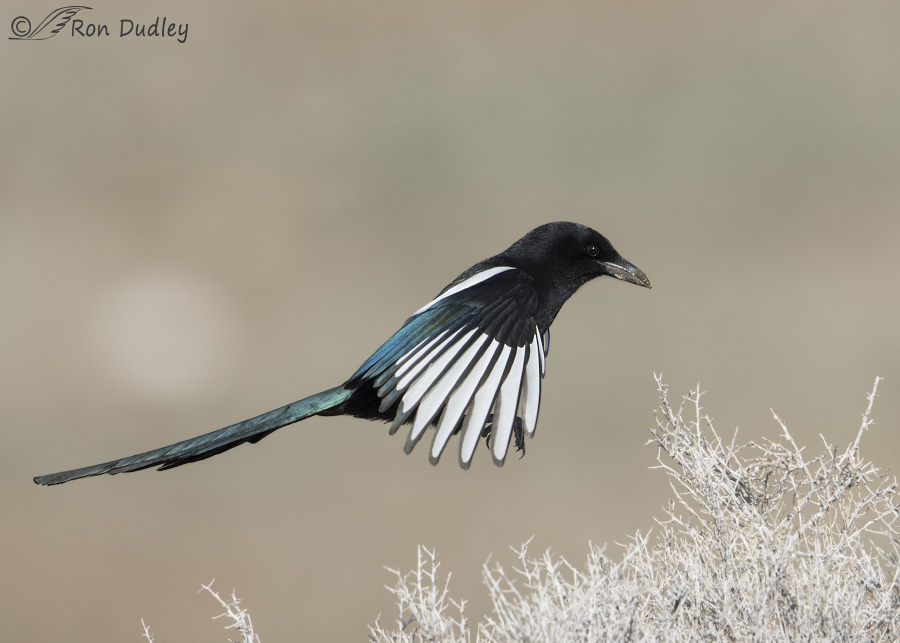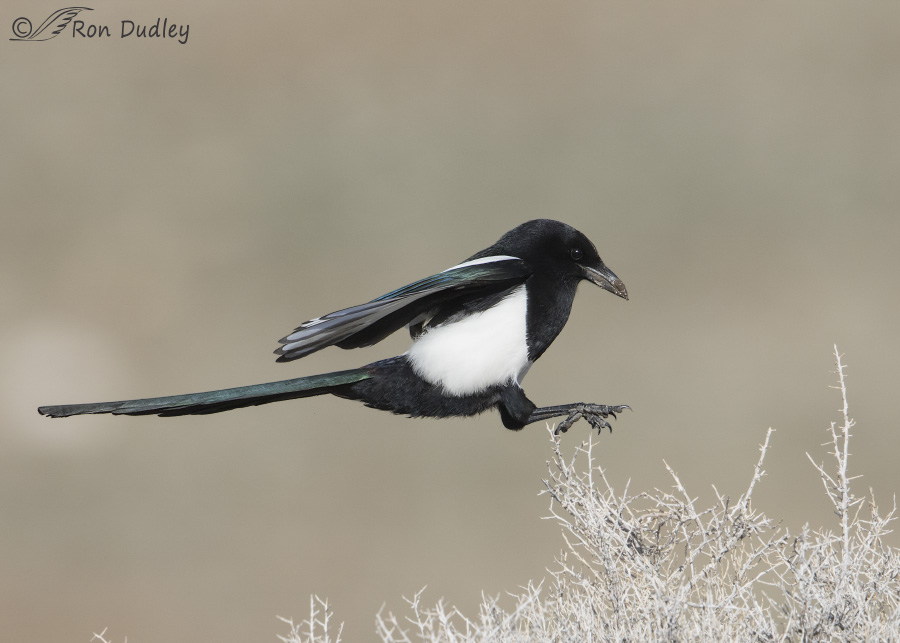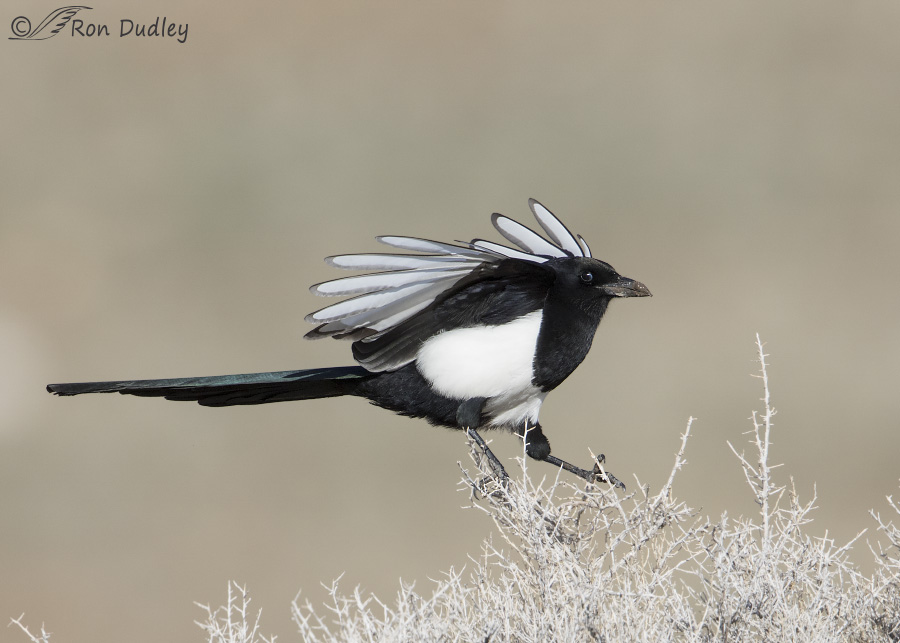I like these images not because they’re flashy but because they’re just a little bit different.
For reasons that should be obvious, photographing birds as they land is usually much more difficult than at takeoff so we don’t see many landing shots posted on the web. I try to practice landing shots whenever I have the opportunity and I had just that with Black-billed Magpies two days ago on Antelope Island.
One of several reasons birds are difficult to photograph landing is that you seldom know where they’re going to touch down. But on this morning as I was photographing these magpies near their nest bush I noticed that (unlike previous days I’d spent with them) they were consistently landing on the same high spot on one of the bushes. The reason for that change in behavior may (or may not) have been related to a stiff and steady north breeze that was blowing. I decided to try to take advantage of the situation so I would prefocus on that high spot and hope I could click the shutter fast enough when I saw a bird entering the frame from my left (with the wind they always came from that direction – they would even circle around in order to do so).
The following three photos are consecutive images in a burst.

1/2500, f/7.1, ISO 400, Canon 7D Mark II, Canon EF 500mm f/4L IS II USM + 1.4 tc, not baited, set up or called in
I didn’t get any spectacular wing and tail positions because they were always flying into the wind as they came in so they had plenty of lift with their wings only partially extended but I still find this image interesting because it just has a different “feel” about it. I like the peekaboo effect of the legs and feet through the wing primaries, the way the magpie seems suspended in air over the intended perch and of course the iridescence.

1/2500, f/7.1, ISO 400, Canon 7D Mark II, Canon EF 500mm f/4L IS II USM + 1.4 tc, not baited, set up or called in
Because of the headwind, in the 1/10th of a second from the first image to the second the bird had only traveled forward a little over an inch (based on the position of the eye relative to the perch in the two shots) but its body posture has changed significantly – especially regarding the feet and wings.

1/2500, f/7.1, ISO 400, Canon 7D Mark II, Canon EF 500mm f/4L IS II USM + 1.4 tc, not baited, set up or called in
Here the magpie is settling into the perch immediately after touch-down..
These aren’t spectacular images but I don’t always need spectacular. I enjoy sequences like this because I can study the mechanics of landing and they always make me wonder what’s going through the mind of the bird as it accomplishes such a complex task so effortlessly. For them the process, once they’ve learned the basics of it as a youngster, is likely mostly a matter of repetition and muscle memory but each landing situation is different so there must be other “stuff” going on too.
More evidence that birds are amazing.
Ron


Magpies.
What a blissful start to the day.
It is pre-sparrow fart here, and not even the birds are stirring BUT I get too see magpies. Yours, not ours, but amazing just the same.
Perhaps because I am a klutz, landing has always fascinated (and awed) me. There is so little room for error.
On the birds taking vengeance on cats line: One of our cats spent a LOT of time watching the magies. Chittering at the magpies. Lusting after the magpies. He was doing so one morning when all of a sudden he SHOT inside the house and retreated under the bed. Wimp of an animal. The magpie had crapped on his head (no doubt deliberately). I laughed.
I remember you telling the cat/magpie story once before, EC. That’s one worth repeating and yet another reason to love magpies!
Once again, the standard OH WOW! I hadn’t realized the shortage of landing-bird photos, but you’re right! And like you, I like seeing the mechanics of how they do things. One thing that still mystifies me, even after all these years, is when they’re in a headlong power dive after prey, I’ve never actually seen when they employ the landing/killing gear. Obviously, they do it way faster than I CAN see (we humans are comparatively blind) and seemingly at the very last fraction of a second.
Yes, magpies can be obnoxious, as can all their corvid kin, however, they’re also good as early-warning devices for hawks/falcons in the neighborhood, too, so it all works out. Plus, they’re way smarter than me and I love watching them prove that.
Patty, it continually amazes me just how lightly they land (usually, unless there’s a tail wind). You wouldn’t believe it, but even a redtail hawk lands with the weight of a feather. Of course, the rest of the weight comes after, but unless there’s a tail wind or they’re not happy with you for some reason (or hormonal–I can’t forget that), they’re light and easy in their landings. And there’s just nothing like watching them choose (and it is a CHOICE) to come to your fist just because you asked them to do it, tidbit or no. Just magical!
My GHO for all his size and power, could land almost like a feather…the crows landed even lighter… could barely feel the Grackles or the Robins…..
Laura, One of my fantasies is to photograph a raptor strike on prey in the air with all the prerequisites – up close with good light and detail and feathers flying from the impact. I’m always referring to the “million dollar shot” that I didn’t get – well that would be it if it ever happened!
Ron you might have to go out with a falconer for that to eliminate about a dozen of the variables in that quest (and there are a bunch of good ones in Utah). Then again, to get it with a wild bird would definitely be a once-in-a-lifetime shot! I would think it’s just a tad easier with a longwing simply because they’re visible in their strikes in the air. Catching that with a redtail brings in the variable of other stuff on the ground. Darn those variables! But isn’t it grand to tilt at windmills? I’ve done my share of that.
For me it just wouldn’t be the same, Laura. I want it to be a wild bird with no setup. That’s a windmill I’ve tilted at for so long that I’m lopsided…
Yeah, I get that Ron. And I tilt at several windmills, too. Stubborn tenacity gets me through the day!
More stubborn than stains has brought me many a benefit. And some frustration…
Ron, I would be very interested in such a series. Some years ago, as I was driving to work, I saw a blackbird harassing a hawk ( not sure what kind of either). The hawk suddenly flew up, made a loop, nabbed the offender right out of the air, flew to nearby tree, and started plucking his catch…feathers flying everywhere…it was definitely justifiable birdacide….
Patty, it’s never wise to give a raptor half an opportunity. They’re always looking for weakness and a moment of not thinking clearly, and WHAMMO, come join me for dinner!
I’d love to have seen that, Patty.
A few years ago I started finding piles of magpie feathers on the hay bales in the field and other places on the farm. Before that I never thought any critter would eat a magpie, especially cats. Then one day while out feeding some hay to the calves, I heard a commotion and braking branches in some nearby cottonwood trees and looked up to see a coopers hawk taking a magpie to the ground. The magpie had been setting in the top of the tree and the hawk had come diving out of the sky and nabbed it. The hawk held it in his claws on the ground for a few moments and then flew off with it.
That would have been some sight to see, Marvin. The largest prey I’ve seen a Cooper’s Hawk take is a Mourning Dove. There’s a photo of that hawk with the dove here if you’re interested:
https://www.featheredphotography.com/blog/2010/09/26/the-frustrations-of-unnatural-perches/
Regarding magpies and cats – one of the funniest things I’ve EVER seen was a magpie tormenting a cat. The cat was laying on the grass with its tail stretched out behind it and the magpie repeatedly came up from behind and pulled and bit its tail. The cat knew it was coming but the magpie was faster so the cat couldn’t prevent it. All the cat had to do to prevent it was leave the area but it didn’t. It really wanted to get that magpie but I never saw it even come close, though it tried repeatedly.
Just another reason I love magpies…
Mariah (female redtail) caught a magpie, presumably not paying attention as it perched inside a thick bush. I was flabbergasted, but she caught it fair and square. She almost caught a chukar once, too–that was SO close! That was when we lived in Wyoming. These raptors just haven’t read the rules about what they can and cannot do! They don’t have maps, either!
One of our Grackles used to do that to our dog, “Collie”, a Viszla/golden retreiver cross..while she was sitting, he would pull at end of her tail, land on the middle of her her back and slide down, then repeat…even sometimes landed on her head…there were many heart-stopping moments…she’d show her teeth as if to say,”Get your damned bird off of me…NOW …or else !”, but never hurt anything that I ID’d as “Mine”… An amazing dog…very smart.
I checked pit this link…glad I did…some very interesting shots!
Ron, in my experience things are the other way around: photographing birds at take off has always been harder than during landing, because the instant of the take off is very hard to predict (though there are some signs in some species) whereas in many species the landing site is repetitive or can be anticipated (particularly in insectivores and some raptors). A question: you state that your second (and beautiful) image of the landing magpie was taken 1/10th of a second after the first, but if both are consecutive and the shutter speed was 1/2500, then the span between both shots should be 1/2500 of a second, or am I confused?
Ricardo, Interesting that you find landing shots easier. I agree that if you know where the bird will likely land that makes the odds of success in the two types of shots more even. But with the birds I usually shoot I can seldom anticipate where they’ll land. Maybe that’s the difference?
The time between consecutive shots in a burst isn’t usually limited by shutter speed, it’s limited by the burst rate of the camera. With a fast memory card my 7D Mark II in a burst shoots 10 frames/sec, no matter the shutter speed (unless it’s very, very slow).
If burst rate were determined by shutter speed I could shoot 2500 shots in a second at a SS of 1/2500. If only it were so…
Ron thank you for solving my burst speed confusion. Best regards, Ricardo
Wonderful Ron!
Charlotte
Thanks, Charlotte.
Good shots, Ron – they are pretty, smart birds even if on my “list” on a regular basis!
Judy, I once had a pair nesting in a tree next to my house and when they’d start squawking at about 4 AM they were on my “list” too…
I love any image of a Magpie…these are different and interesting. Although they look so solid, these images show how lightly they can land and how thin the perch that can hold them. With all the times I saw these elegant birds, I never found a feather….wish I had…love the combination of white with black edging on the primaries….
Thanks, Patty. I don’t remember ever seeing one of their feathers on the ground either but then I never approach their nests.
I don’t think I ever even saw their nests. I hope to heck I never approached one or disturbed them. I mainly saw them on open ground, by the roadsides, or in a huge cottonwood….i’ve a couple of dead ones on the road…sad.
Patty, their nests are distinctive, big structures including a roof. So they’re pretty hard to miss.
They are VERY easy to miss if you’re not in a nesting area. Thanks to Ron and my own curiousity, if I’d been near one, I would have recognized it…
Great photos, Ron. Just yesterday as I was looking over photos of some birds in the tree in our backyard it struck me that most are perched and I really need to work on getting take-off and landing shots…mix it up and get something different. Then you post this. Your photos give me something to aspire to. The Black-billed Magpie looks like a cool bird. We don’t have those in Northeast Ohio. What a shame.
I like the variety of different kinds of images too, Dave. Getting them is also a skill-building process that pays off down the road.
Black-billed Magpies are wonderful birds for lots of reasons, though some folks aren’t huge fans of them because they can be loud and “obnoxious” in certain situations.